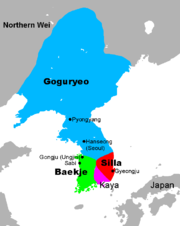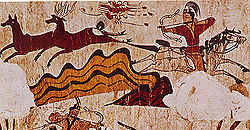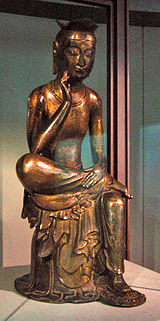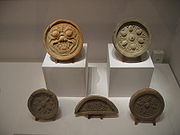Three Kingdoms of Korea
| Three Kingdoms of Korea | |
|---|---|
 Map of the Three Kingdoms of Korea, at the end of the 5th century. |
|
| Korean name | |
| Hangul | 삼국시대 |
| Hanja | 三國時代 |
| Revised Romanization | Samguk Sidae |
| McCune–Reischauer | Samguk Sidae |
The Three Kingdoms of Korea (Hangul: 삼국시대; Hanja: 三國時代) refer to the ancient Korean kingdoms of Goguryeo, Baekje and Silla, which dominated the Korean peninsula and parts of Manchuria for much of the 1st millennium CE. The Three Kingdoms period ran from 57 BC until Silla's triumph over Goguryeo in 668, which marked the beginning of the North and South States period (남북국시대) of Unified Silla in the South and Balhae in the North.
The earlier part of this period, before the three states developed into full-fledged kingdoms, is sometimes called Proto-Three Kingdoms of Korea.
Contents |
Background
The name "Three Kingdoms" was used in the titles of the histories Samguk Sagi (12th century) and Samguk Yusa (13th century), and should not be confused with the earlier Chinese Three Kingdoms.
The Three Kingdoms were founded after the fall of Gojoseon, and gradually conquered and absorbed various other small states and confederacies. After the fall of Gojoseon, the Han dynasty established four commanderies in northern parts of the Korean peninsula. Three fell quickly to the Samhan, and the last was destroyed by Goguryeo in 313.
The nascent precursors of Baekje and Silla expanded within the web of complex chiefdoms during the Proto Three Kingdoms Period, and Goguryeo conquered neighboring Buyeo, Okjeo, Dongye, and other complex chiefdoms in northern Korea and Manchuria. The three polities made the transition from complex chiefdom to full-fledged state-level societies in the 3rd century.
All three kingdoms shared a similar culture and language. Their original religions appear to have been shamanistic, but they were increasingly influenced by Chinese culture, particularly Confucianism and Taoism. In the 4th century, Buddhism was introduced to the peninsula and spread rapidly, briefly becoming the official religion of all three kingdoms.
Goguryeo
| History of Korea | |
|---|---|
 This article is part of a series |
|
| Prehistory | |
| Jeulmun period | |
| Mumun period | |
| Gojoseon 2333–108 BCE | |
| Jin | |
| Proto-Three Kingdoms 108–57 BCE | |
| Buyeo, Okjeo, Dongye | |
| Samhan: Ma, Byeon, Jin | |
| Three Kingdoms 57 BCE – 668 CE | |
| Goguryeo 37 BCE – 668 CE | |
| Baekje 18 BCE – 660 CE | |
| Silla 57 BCE – 935 CE | |
| Gaya 42–562 | |
| North-South States 698–935 | |
| Unified Silla 668 – 935 CE | |
| Balhae 698–926 | |
| Later Three Kingdoms 892–935 | |
| Taebong, Hubaekje, Silla | |
| Goryeo Dynasty 918–1392 | |
| Joseon Dynasty 1392–1897 | |
| Korean Empire 1897–1910 | |
| Japanese occupation 1910–1945 | |
| Provisional Gov't 1919–1948 | |
| Division of Korea 1945–1948 | |
| North, South Korea 1948–present | |
| Korean War 1950–1953 | |
| By topic | |
| Timeline | |
| List of monarchs | |
| Linguistic history | |
| Science and technology history | |
| Art history | |
| Military history | |
| Naval history | |
|
Korea Portal |

Goguryeo emerged on the north and south banks of the Yalu (Amrok) River, in the wake of Gojoseon's fall. The first mention of Goguryeo in Chinese records dates from 75 BCE in reference to a commandery established by the Chinese Han dynasty, although even earlier mentions of "Guri" may be of the same state. Evidence indicates Goguryeo was the most advanced, and likely the first established, of the three kingdoms.
Goguryeo, eventually the largest of the three kingdoms, had several capitals in alternation: two capitals in the upper Yalu area, and later Nangrang (樂浪: Lelang in Chinese) which is now part of Pyongyang. At the beginning, the state was located on the border with China; it gradually expanded into Manchuria and destroyed the Chinese Lelang commandery in 313. The cultural influence of the Chinese continued as Buddhism was adopted as the official religion in 372.
The Empire was at its zenith in the fifth century during the rule of King Gwanggaeto the Great and his son King Jangsu in their campaign against China in Manchuria. For the next century or so, Goguryeo was the dominant empire in the Korean peninsula.[1] Goguryeo eventually occupied the Liaodong Plains in Manchuria and today's Seoul area. Goguryeo controlled not only Koreans but also Chinese and other Tungusic tribes in Manchuria and North Korea. After the establishment of the Sui Dynasty and later the Tang Dynasty in China, the empire continued to suffer from Chinese attacks until conquered by an allied Silla-Tang forces in 668.
Baekje

Baekje was founded as a member of the Mahan confederacy. Two sons of Goguryeo's founder are recorded to have fled a succession conflict, to establish Baekje around the present Seoul area.
Baekje absorbed or conquered other Mahan chiefdoms and, at its peak in the 4th century, controlled most of the western Korean peninsula. Under attack from Goguryeo, the capital moved south to Ungjin (present-day Gongju) and later further south to Sabi (present-day Buyeo).
Baekje exerted its political influence on Tamna, a kingdom of Jeju Island. Baekje maintained a close relationship with and extracted tribute from Tamna. Baekje's religious and artistic culture influenced Goguryeo and Silla.
Buddhism was introduced to Baekje in 384 from Goguryeo, which Baekje welcomed.[1] Later, Baekje played a fundamental role in transmitting cultural developments, including Chinese characters and Buddhism, into ancient Japan.[2][1] Baekje was conquered by an alliance of Silla and Tang forces in 660.
Silla
According to Korean records, in 57 BCE, Seorabeol (or Saro, later Silla) in the southeast of the peninsula unified and expanded the confederation of city-states known as Jinhan. Although Samguk Sagi records that Silla was the earliest-founded of the three kingdoms, other written and archaeological records indicate that Silla was likely the last of the three to establish a centralized government.
Renamed from Saro to Silla in 503, the kingdom annexed the Gaya confederacy (which in turn had absorbed Byeonhan earlier) in the first half of the 6th Century. Goguryeo and Baekje responded by forming an alliance. To cope with invasions from Goguryeo and Baekje, Silla deepened its relations with the Tang Dynasty, with her newly gained access to the Yellow Sea making direct contact with the Tang possible. After the conquest of Goguryeo and Baekje with her Tang allies, the Silla kingdom drove the Tang forces out of the peninsula and occupied the lands south of Pyongyang.
The capital of Silla was Seorabeol (now Gyeongju). Buddhism became the official religion in 528. The remaining material culture from the kingdom of Silla including unique gold metalwork shows influence from the northern nomadic steppes, differentiating it from the culture of Goguryeo and Baekje where Chinese influence was more pronounced.
Other states
Other smaller states existed in Korea before and during this period:
- Gaya confederacy, until annexed by Silla
- Dongye, Okjeo, and Buyeo, all three conquered by Goguryeo
- Usan (Ulleung-do) tributary of Silla
- Tamna (Jeju-do) tributary of Baekje

End of the Three Kingdoms Period
Allied with China under the Tang dynasty, Silla conquered Goguryeo in 668, after having already conquered Gaya in 562 and Baekje in 660, thus ushering in the North-South states period with Later Silla to the south and Balhae to the north.
Archaeological perspectives on the Three Kingdoms of Korea

Archaeologists use theoretical guidelines derived from anthropology, ethnology, analogy, and ethnohistory to the concept of what defines a state-level society. This is different from the concept of state (guk or Sino ko: 國, walled-town state, etc) in the discipline of Korean History. In anthropological archaeology the presence of urban centres (especially capitals), monumental architecture, craft specialization and standardization of production, ostentatious burials, writing or recording systems, bureaucracy, demonstrated political control of geographical areas that are usually larger in area than a single river valley, etc make up some of these correlates that define states.[3] Among the archaeology sites dating to the Three Kingdoms of Korea, hundreds of cemeteries with thousands of burials have been excavated. The vast majority of archaeological evidence of the Three Kingdoms Period of Korea consists of burials, but since the 1990s there has been a great increase in the archaeological excavations of ancient industrial production sites, roads, palace grounds and elite precincts, ceremonial sites, commoner households, and fortresses due to the boom in salvage archaeology in South Korea.
Rhee and Choi hypothesize that a mix of internal developments and external factors lead to the emergence of state-level societies in Korea.[4] A number of archaeologists including Kang demonstrate the role of frequent warfare in the development of peninsular states[5].[6][7]
Formation of Goguryeo, Silla, and Baekje States (c. 0 – 300/400 CE)

Some individual correlates of complex societies are found in the chiefdoms of Korea that date back to c. 700 BC (e.g. see Igeum-dong, Songguk-ri).[8][4] However, the best evidence from the archaeological record in Korea indicates that states formed between 300 BCE and 300/400 CE [9][10][11][12].[13][14] However, archaeologists are not prepared to suggest that this means there were states in the BCE era. The correlates of state-level societies did not develop as a package, but rather in spurts and starts and at various points in time. It was some time between 100 CE – 400 CE that individual correlates of state societies had developed to a sufficient number and scale that state-level societies can be confidently identified using archaeological data.
Evidence from burials
Lee Sung-joo analyzed variability in many of the elite cemeteries of the territories of Silla and Gaya polities and found that as late as the 2nd century AD there was intra-cemetery variation in the distribution of prestige grave goods, but there was an absence of hierarchical differences on a regional scale between cemeteries. Near the end of the 2nd century CE, interior space in elite burials increased in size, and wooden chamber burial construction techniques were increasingly used by elites. In the 3rd century, a pattern developed in which single elite cemeteries that were the highest in status compared to all the other cemeteries were built. Such cemeteries were established at high elevations along ridgelines and on hilltops. Furthermore, the uppermost elite were buried in large-scale tombs established at the highest point of a given cemetery.[15] Cemeteries with 'uppermost elite' mounded burials such as Okseong-ri, Yangdong-ri, Daeseong-dong, and Bokcheon-dong display this pattern.

Evidence from factory-scale production of pottery and roof-tiles
Lee Sung-joo proposed that, in addition to the development of regional political hierarchies as seen through analysis of burials, variation in types of pottery production gradually disappeared and full-time specialization was the only recognizable kind of pottery production from the end of the 4th century A.D. At the same time the production centres for pottery became highly centralized and vessels became standardized.[15]
Centralisation and elite control of production is demonstrated by the results of the archaeological excavations at Songok-dong and Mulcheon-ni in Gyeongju. These sites are part of what was an interconnected and sprawling ancient industrial complex on the northeast outskirts of the Silla capital. Songok-dong and Mulcheon-ri are an example of the large-scale of specialized factory-style production in the Three Kingdoms and Unified Silla Periods. The site was excavated in the late 1990s, and archaeologists found the remains of many production features such as pottery kilns, roof-tile kilns, charcoal kilns, as well as the remains of buildings and workshops associated with production.
Capital cities, elite precincts, and monumental architecture
Since 1976, continuing archaeological excavations concentrated in the southeastern part of modern Gyeongju have revealed parts of the so-called Silla Wanggyeong (Silla capital). A number of excavations over the years have revealed temples such as Hwangnyongsa, Bunhwangsa, Heungryunsa, and 30 other sites. Signs of Baekje's capitals have also been excavated at the Mongchon Fortress and the Pungnap Fortress in Seoul.
See also
- Heavenly Horse Tomb
- History of Korea
- List of Korean monarchs
- Korean pottery and porcelain
- Korean Pottery: Categorized by Periods
References
- ↑ 1.0 1.1 1.2 Korea's Three Kingdoms
- ↑ [1]
- ↑ Rhee, S.N. and M.L. Choi. 1992. Emergence of complex society in Korea. Journal of World Prehistory 6(1):89-91.
- ↑ 4.0 4.1 Rhee and Choi 1992
- ↑ Kang, Bong-won. (1995). The role of warfare in the formation of state in Korea: Historical and archaeological approaches. PhD dissertation. University of Oregon, Eugene. Ann Arbor: University Microfilms.
- ↑ Kang, Bong-won. (2000). A test of increasing warfare in the Samguk Sagi against the archaeological remains in Yongnam, South Korea. Journal of East Asian Archaeology 2(2-4):139-197.
- ↑ Rhee and Choi 1992:90
- ↑ Bale, Martin T. and Ko, Min-jung (2006). Craft Production and Social Change in Mumun Pottery Period Korea. Asian Perspectives 45(2):159-187.
- ↑ Barnes, Gina L. (2001). State formation in Korea: Historical and archaeological perspectives. Richmond, Surrey: Curzon. ISBN 0-7007-1323-9
- ↑ Barnes, Gina L. (2004). The emergence and expansion of Silla from an archaeological perspective. Korean Studies 28:15-48.
- ↑ Kang 1995
- ↑ Kang 2000
- ↑ Lee, Sung-joo. 1998. Silla - Gaya Sahwoe-eui Giwon-gwa Seongjang [The Rise and Growth of Society in Silla and Gaya]. Seoul: Hakyeon Munhwasa.
- ↑ Pai, Hyung Il. (1989). Lelang and the "interaction sphere": An alternative approach to Korean state formation. Archaeological Review from Cambridge 8(1):64-75.
- ↑ 15.0 15.1 Lee 1998
- Best, J.W. (2003). Buddhism and polity in early sixth-century Paekche. Korean Studies 26(2), 165-215.
- Lee, K. (1984). A New History of Korea. Tr. by E.W. Wagner & E.J. Schulz, based on 1979 rev. ed. Seoul: Ilchogak.
- Na H.L. (2003). Ideology and religion in ancient Korea. Korea Journal 43(4), 10-29.[2]
- Nelson, Sarah M. (1993). The archaeology of Korea. Cambridge: Cambridge University Press.
- Pearson R, J.W. Lee, W.Y. Koh, and A. Underhill. (1989). Journal of Anthropological Archaeology 8(1):1-50.
- http://www.chungdong.or.kr/highroom/history/map/index.htm